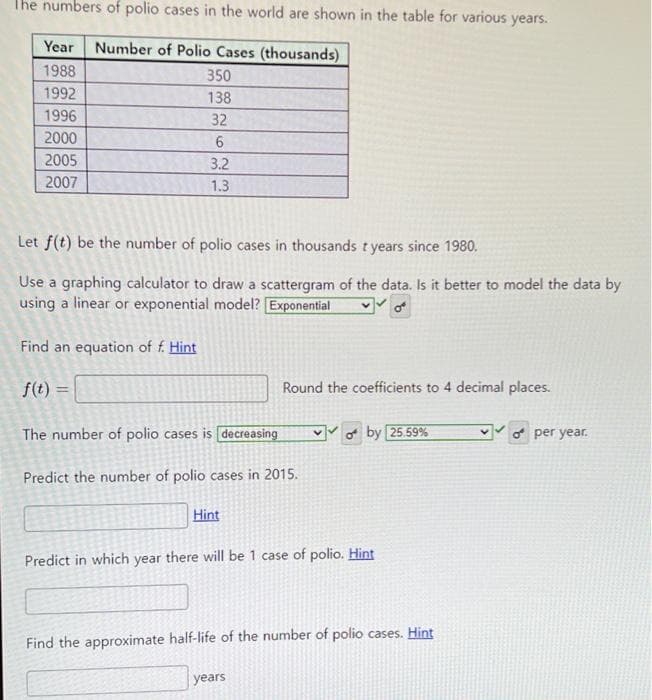The numbers of polio cases in the world are shown in the table for various years. Year Number of Polio Cases (thousands) 1988 350 1992 138 1996 32 2000 6. 2005 3.2 2007 1.3 Let f(t) be the number of polio cases in thousands t years since 1980. Use a graphing calculator to draw a scattergram of the data. Is it better to model the data using a linear or exponential model? Exponential of Find an equation of f. Hint f(t) Round the coefficients to 4 decimal places. %3D The number of polio cases is decreasing vo by 25.59% o per year. Predict the number of polio cases in 2015. Hint Predict in which year there will be 1 case of polio. Hint Find the approximate half-life of the number of polio cases. Hint years
The numbers of polio cases in the world are shown in the table for various years. Year Number of Polio Cases (thousands) 1988 350 1992 138 1996 32 2000 6. 2005 3.2 2007 1.3 Let f(t) be the number of polio cases in thousands t years since 1980. Use a graphing calculator to draw a scattergram of the data. Is it better to model the data using a linear or exponential model? Exponential of Find an equation of f. Hint f(t) Round the coefficients to 4 decimal places. %3D The number of polio cases is decreasing vo by 25.59% o per year. Predict the number of polio cases in 2015. Hint Predict in which year there will be 1 case of polio. Hint Find the approximate half-life of the number of polio cases. Hint years
Linear Algebra: A Modern Introduction
4th Edition
ISBN:9781285463247
Author:David Poole
Publisher:David Poole
Chapter7: Distance And Approximation
Section7.3: Least Squares Approximation
Problem 31EQ
Related questions
Question
(please solve it correctly within 15 minutes donot copy other from any source )

Transcribed Image Text:The numbers of polio cases in the world are shown in the table for various years.
Year Number of Polio Cases (thousands)
1988
350
1992
138
1996
32
2000
6.
2005
3.2
2007
1.3
Let f(t) be the number of polio cases in thousands t years since 1980.
Use a graphing calculator to draw a scattergram of the data. Is it better to model the data by
using a linear or exponential model? Exponential
Find an equation of f. Hint
f(t) =
Round the coefficients to 4 decimal places.
The number of polio cases is decreasing
Yo by 25.59%
o per year.
Predict the number of polio cases in 2015.
Hint
Predict in which year there will be 1 case of polio. Hint
Find the approximate half-life of the number of polio cases. Hint
years
Expert Solution
This question has been solved!
Explore an expertly crafted, step-by-step solution for a thorough understanding of key concepts.
This is a popular solution!
Trending now
This is a popular solution!
Step by step
Solved in 6 steps with 1 images

Recommended textbooks for you

Linear Algebra: A Modern Introduction
Algebra
ISBN:
9781285463247
Author:
David Poole
Publisher:
Cengage Learning

Glencoe Algebra 1, Student Edition, 9780079039897…
Algebra
ISBN:
9780079039897
Author:
Carter
Publisher:
McGraw Hill

Big Ideas Math A Bridge To Success Algebra 1: Stu…
Algebra
ISBN:
9781680331141
Author:
HOUGHTON MIFFLIN HARCOURT
Publisher:
Houghton Mifflin Harcourt

Linear Algebra: A Modern Introduction
Algebra
ISBN:
9781285463247
Author:
David Poole
Publisher:
Cengage Learning

Glencoe Algebra 1, Student Edition, 9780079039897…
Algebra
ISBN:
9780079039897
Author:
Carter
Publisher:
McGraw Hill

Big Ideas Math A Bridge To Success Algebra 1: Stu…
Algebra
ISBN:
9781680331141
Author:
HOUGHTON MIFFLIN HARCOURT
Publisher:
Houghton Mifflin Harcourt

Algebra & Trigonometry with Analytic Geometry
Algebra
ISBN:
9781133382119
Author:
Swokowski
Publisher:
Cengage

Algebra and Trigonometry (MindTap Course List)
Algebra
ISBN:
9781305071742
Author:
James Stewart, Lothar Redlin, Saleem Watson
Publisher:
Cengage Learning